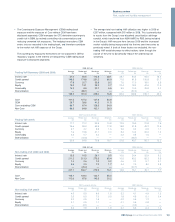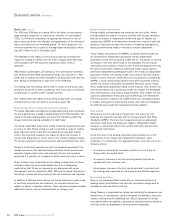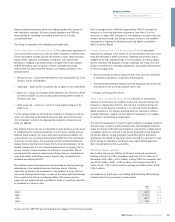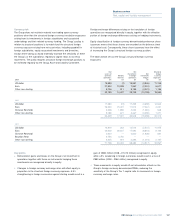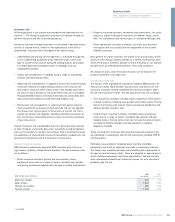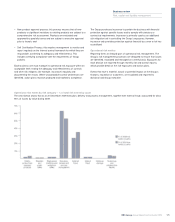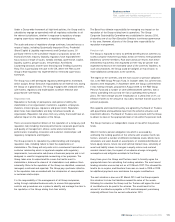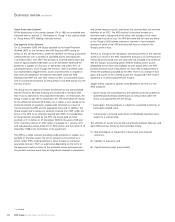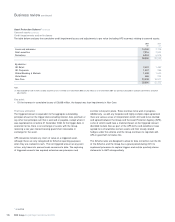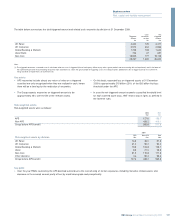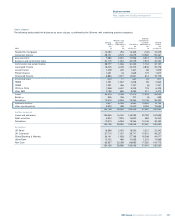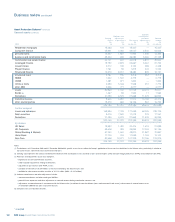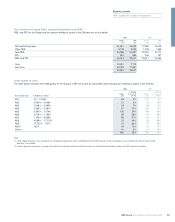RBS 2009 Annual Report Download - page 175
Download and view the complete annual report
Please find page 175 of the 2009 RBS annual report below. You can navigate through the pages in the report by either clicking on the pages listed below, or by using the keyword search tool below to find specific information within the annual report.
Business review
Risk, capital and liquidity management
173RBS Group Annual Report and Accounts 2009
Under a Group-wide framework of high-level policies, the Group and its
subsidiaries engage co-operatively with all regulatory authorities in all
the relevant jurisdictions, whether in response to regulatory change,
ongoing supervisory requirements or regulatory investigations.
The scale and pace of regulatory change continues, focused across a
range of topics, including Systemically Important Firms, Prudential
(Basel Capital & Liquidity requirements) and Conduct issues. Of
particular interest is the cumulative impact of proposals across the
financial services industry. Globally, regulators have expanded their
focus across a range of issues, notably strategic, governance, capital,
liquidity, systems, people issues, remuneration, Anti Money
Laundering/sanctions and terrorist financing and Treating Customers
Fairly. This is particularly the case in the UK, where the FSA (as the
Group’s lead regulator) has implemented an enhanced supervisory
framework.
The Group has a well developed regulatory developments framework,
which assigns Senior Executive responsibility for all material risks facing
the Group on a global basis. The Group engages with standard setters,
rule makers, regulators and trade bodies to deliver effective and
proportionate rule making.
Reputation risk
Reputation is the body of perceptions and opinions held by the
stakeholders of an organisation; customers, suppliers, employees,
investors, interest groups, regulators and government. Reputation
determines how stakeholders are likely to behave towards an
organisation. Reputation risk arises from any activity that could have an
adverse impact on the reputation of the Group.
There are several important drivers of the reputation of a company (and
reputation risk) including: financial performance; corporate governance
and quality of management; ethical, social and environmental
performance; marketing, innovation and customer relationships; and
regulatory compliance and litigation.
The Group protects its reputation by understanding and managing
reputation risks, including failure to meet the expectations of
stakeholders. The Group will only enter into a commercial transaction or
customer relationship which is legal and complies with regulatory
requirements, has economic substance or business purpose and is not
designed or used for inappropriate accounting or tax purposes. The
Group takes care to understand the issues that matter most to
stakeholders, balance the views of all stakeholders and address them
coherently. Risks to the reputation of the Group are identified, assessed,
managed, monitored and reported. The Group pays particular attention
to the reputation risks associated with the introduction of new products
or customer relationships.
It is the responsibility of the management of all Group companies,
acting through individual business units, to ensure that appropriate
controls and procedures are in place to identify and manage the risks to
the reputation of the Group arising from their activity.
The Board has ultimate responsibility for managing any impact on the
reputation of the Group arising from its operations. The Group
Corporate Sustainability Committee was established in January 2010,
chaired by one of our Non-Executive Directors to enhance governance
in this area. However, all parts of the Group take responsibility for
reputation management.
Pension risk
The Group is exposed to risk to its defined benefit pension schemes as
assets comprise investment portfolios which are held to meet projected
liabilities to scheme members. Risk arises because returns from these
investments may be less than expected or there may be greater than
expected increases in the estimated value of the schemes’ liabilities. In
such circumstances, the Group could be obliged, or may choose, to
make additional contributions to the schemes.
The largest of the schemes, and the main source of pension obligation
risk, is the RBS Group Pension Fund. In October 2006, this scheme was
closed to new employees. In November 2009, the Group confirmed that
it was making changes, proposed in August 2009, to the RBS Group
Pension Fund and a number of other defined benefit schemes, with a
view to controlling the cost and the risk of operating these pension
plans. The main change was the introduction of a yearly limit of 2% (or
inflation if lower) to the amount of any salary increase that will count for
pension purposes.
Risk appetite and investment policy are agreed by the Board of Trustees
with quantitative and qualitative input from the scheme actuaries and
investment advisers. The Board of Trustees also consults with the Group
to obtain its view on the appropriate level of risk within the pension fund.
The Group maintains an independent review of risk within the pension
funds.
GALCO monitors pension obligation risk which is assessed by
estimating the funding position of the scheme with a twelve month risk
horizon, and with a number of different confidence levels. Monte Carlo
simulations are used, based on assumptions of statistical distribution of
future equity returns, future real and nominal interest rates, sensitivity of
asset and liability values to changes in equity returns and real and
nominal interest rates, the impact of an adverse change in longevity
assumptions and mitigation available to the Group.
Every three years the Group and Trustees meet to formally agree the
appropriate basis for calculating the funding valuation. The most recent
funding valuation was carried out as at 31 March 2007. This showed the
fund to be in surplus, and therefore there was no need in 2008 or 2009
for additional payments over and above the regular contributions.
The next valuation is due as at 31 March 2010 and the Group expects
this valuation to show that liabilities exceed the value of the assets.
Following this valuation the Group and the Trustees will agree the level
of contributions to be paid to the scheme. This could result in the
amount of contributions payable in 2010 and subsequent years being
materially different from the current estimate for 2010.


